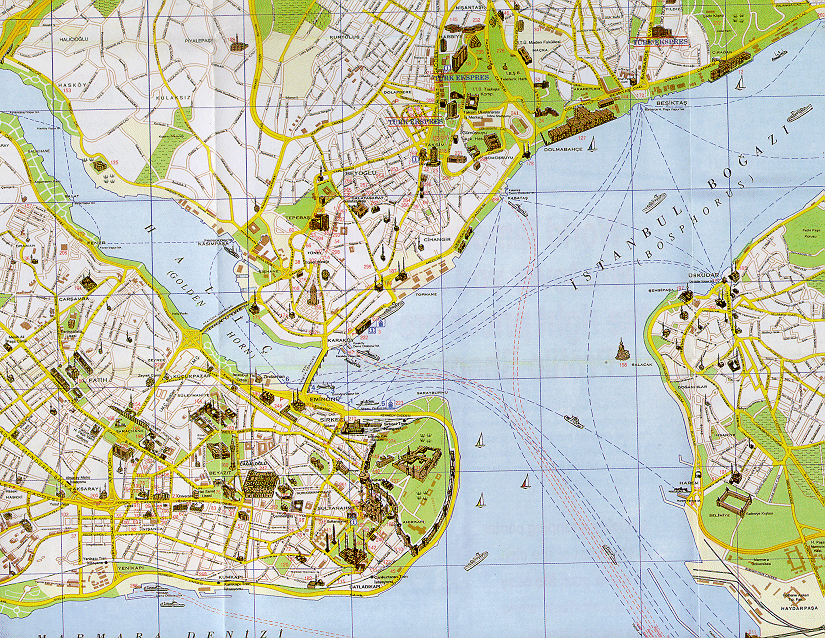In addition to the living areas and
formal rooms, there are also the formal kitchens (they would serve
4,000 people a day here) that included some pots big enough to bathe
in. There was also the treasury exhibit that includes an
86-carat diamond, an inlaid ebony and mother-of-pearl throne, an
emerald-encrusted dagger (called the Topkapi dagger), and a huge array
of pendants, turban pins, and other objects dripping with precious
gems. One could easily see the shift toward western tastes in the
later years in these objects as well. The arms & armor
exhibit was also interesting (though the weapons did look pretty
lethal). Unfortunately, one of the main halls was closed for
restoration, so we missed seeing the collection of miniatures and
religious relics (including one of Muhammad's teeth and some of his whiskers).
We had a great time taking our time and exploring the place. We
had stopped for lunch overlooking the Sea from a balcony one of the
sultans had built and sat in various courtyards soaking in the history
and beauty of the place. It was a fabulous place to spend the day.
We had time to go visit the Spice Bazaar, so we headed over there next.
Gerald's folks had remarked on how frustrated they were when they
visited there that they could not bring some of the goodies home.
We concur completely with them! The vendors had plenty of free
samples of Turkish Delight (which we partook of quite happily), but we
knew we couldn't take home all that we wanted of the spices, sweets,
and dried fruits and nuts that were being offered. We enjoyed sniffing,
seeing and tasting our way up and down the lanes. Locals were buying
things along with the tourists who were visiting there, so it felt more
authentic. We would love to have even
one of the stalls near Storrs.
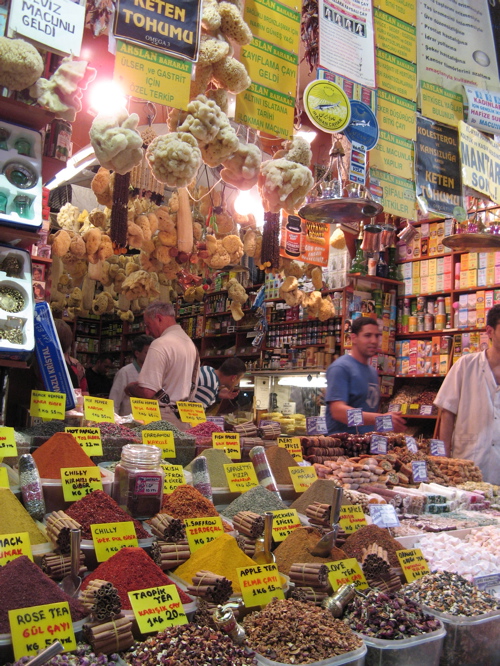
We were a bit tired of walking, so we hopped on one of the commuter
ferries to take a ride on the Bosphorus. It felt great to smell
the fresh air, see the amazing sights, have a glass of tea (of course),
relax and let all that we had seen that day settle in our minds.
It was also fun to see the Topkapi Palace from the sea (below,
left). We decided to stay in Eminönü for dinner so that we
could see the mosques in the evening. We went back to the
Sultanahmet restaurant that we had gone to with Sadik, Sedat and Bayram
and had more of their delicious bean salad and köfte. Sitting on a
bench between the Hagia Sofia and Sultan Ahmet mosque, we watched guys
walk around trying to sell glasses of tea. One of the guys would
just say "chai-chai-chai-chai-chai-chai-chai" really quickly as he
walked around. Made us giggle. They must have had a hot
water tap or something in the bushes right near us because they kept
going in there and coming out with tea. Fun to watch. We
left before full darkness/ full illumination of the buildings, but the
Hagia Sophia (center) and Sultan Ahmet mosque (right) were breathtaking
in the late evening sun.
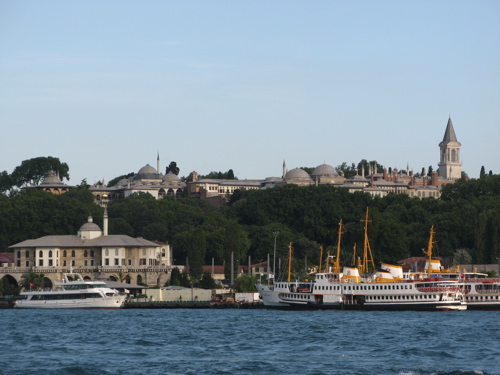

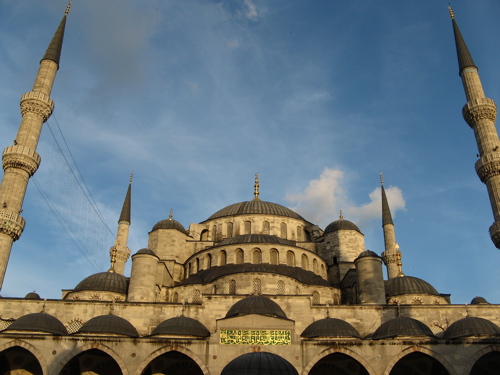
On the tram ride back to Taksim we were able to see the major mosques
and buildings lighted up and it looked spectacular. We had saved
room to go to Saray again for dessert. This time we knew to ask
for a half-portion at least. But we still had two varieties:
Burma Kadayıf
(the vermicelli-pistachio one) and pistachio baklava which was the most
delicious baklava we had ever tasted (very buttery vs. honey-ey).
Saturday morning we headed back to the Topkapi museum area to visit the
three museums nearby: the Archeology Museum, the Museum of the Orient,
and the Tiled Pavilion. We started in the Archeology Museum and
knew we were in for a treat when we walked into the first room and saw
a gigantic sarcophagus with incredible carvings on it. Ends up
the Royal Tomb of Sidon, dating from the 4th century BC, had been found
in 1887 by a farmer working his land. King Abdalonymos's tomb was
the first one we saw and it is amazing. The carvings are
extremely realistic and expressive and there were still remnants of the
colors that had been used to paint it. Other than the weapons in
the carvings having been broken off and/or stolen, it looked like it
was recently carved. We must have circled around looking at it
for 15-20 minutes. The picture on the left is a detail from the
King's sarcophagus; the one on the right gives you a sense of the size
of these things. Much of this section of the museum was focused
on burial - steles,
sarcophogi, and even this mummy with hair left on his scalp (can't wait
to show that to the students). There were tombstones for
whole
families, for gladiators, and even for favorite dogs. It was
interesting to read the translations of some of the inscriptions,
including poems and curses.

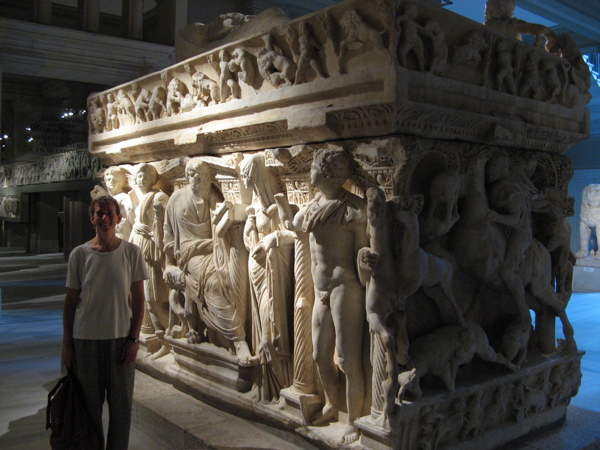
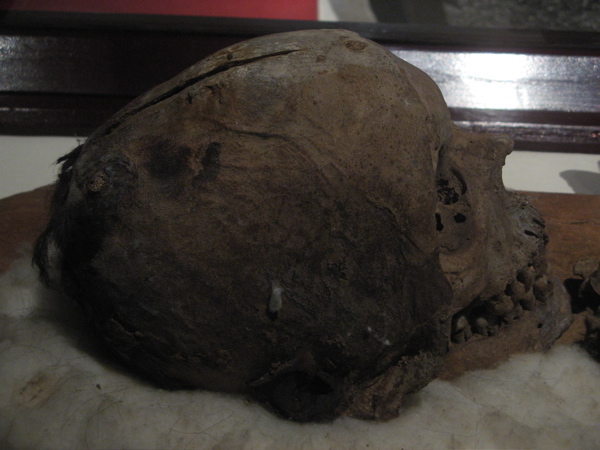
We took a break for a hot
chocolate/Turkish coffee in the garden that was filled with huge
statues, parts of columns and blocks of red marble. It was
relaxing and beautiful. For a change of pace, we took a quick
walk through the Tiled Pavillion. This features pottery through
the ages. It was interesting and there were some beautiful
pieces, but on the whole it paled in comparison to the Topkapi Palace's
collection.
When we went back into the Archeology Museum, we went through a
section of sculptures that included this beautiful one of a young
athlete resting after his workout and this man who looks like he's
looking right through you, doesn't he?
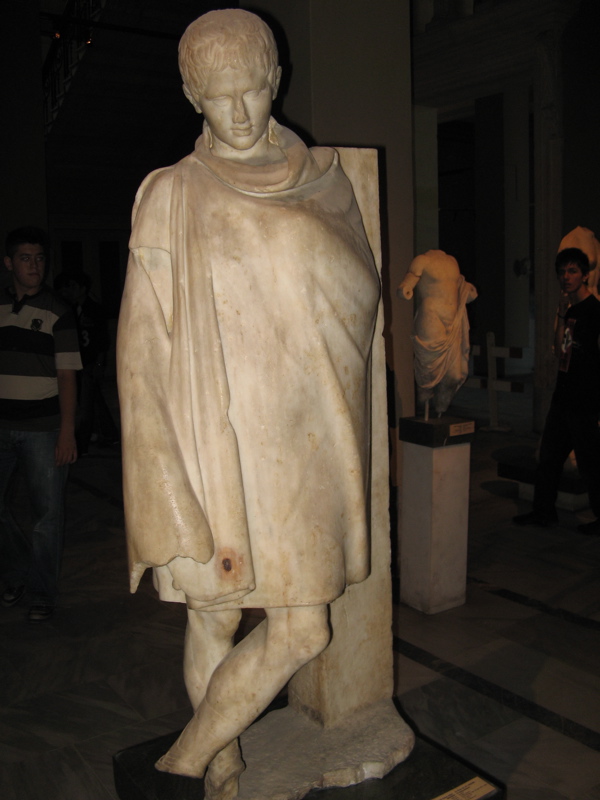
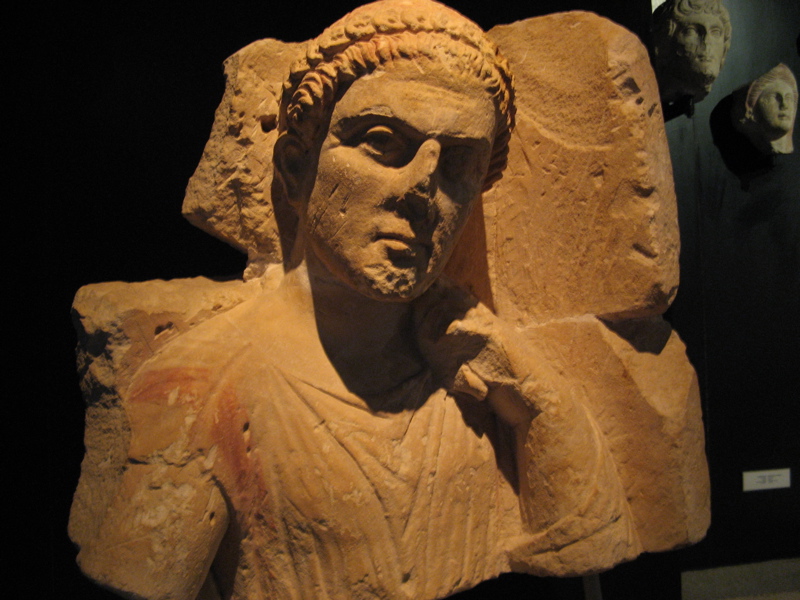
Elyse had read that there was a copy of the first written peace treaty
(between the Hittite King Hattušiliš and Raamses II in
1269 BC) and wanted to see it since she teaches about it in her
classes. We asked the guard and were directed to the Museum of
the Orient. This has art and artifacts from many different
countries in the area. It was amazing to see the treaty "in
person"and to read the translation (including the statement that the
Egyptian version slants things to make Raamses look better.) There was
an interesting collection of cuneiform tablets there that included part
of Hammurabi's Law Code (Elyse teaches about it), the oldest love poem
(that made Gerald's eyes roll) and everyday things like a
multiplication table - all in cuneiform on clay tablets from the
18th century BC! There were also sections of the Great
Ishtar Gate in Babylon (that Elyse also talks about in class),
including huge relief panels that were colorful and looked newly made.
We ended up seeing a lot of beautiful sculptures, reliefs and
artifacts in this museum, but we were running out of steam, so we went
through it quickly. One could easily spend a week among the two
main museums.
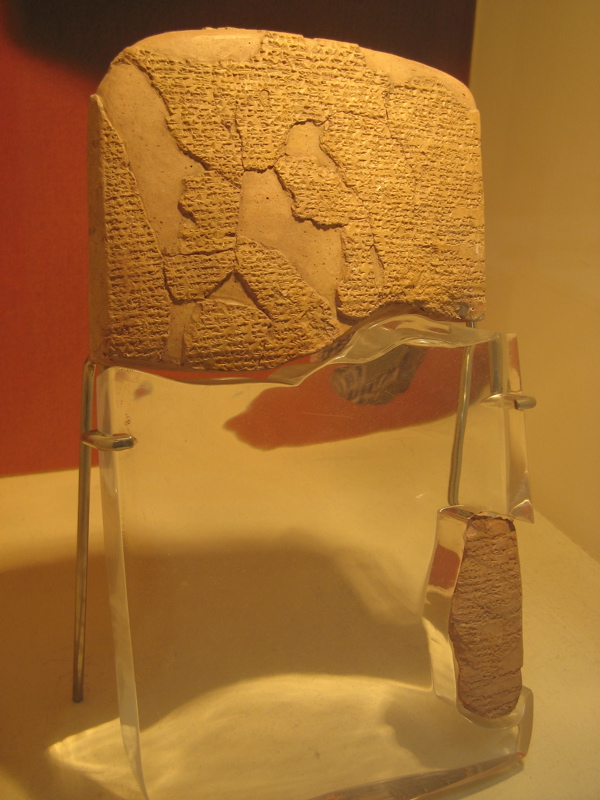
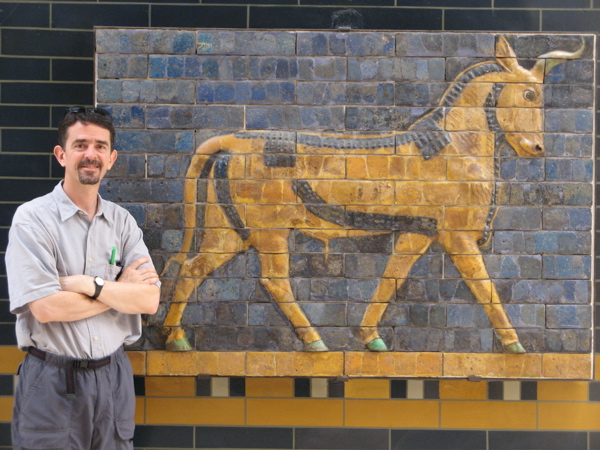
We had talked about taking a ferry up
the Bosphorus toward the entrance to the Black Sea and discovered that
there was one leaving about 10 minutes after we asked the Tourist
Information lady about it. So we ran over to the piers and hopped
on the boat and spent the next 5 hours enjoying the fresh air and
views. It was a glorious day and the water was a turquoise blue
(trivia - did you know that the word turquoise comes from Turk
quartz?). We enjoyed seeing the familiar sights again (more yelis
(houses) and old mansions, the Galata Tower, the palaces, the mosques, the castle, etc.)
and then noting how long it took (about 1 1/2 hours) before the
coastline became less developed. This city is huge! Most of
the areas are still a nice mix of green and buildings though; only a
few had been overdeveloped.
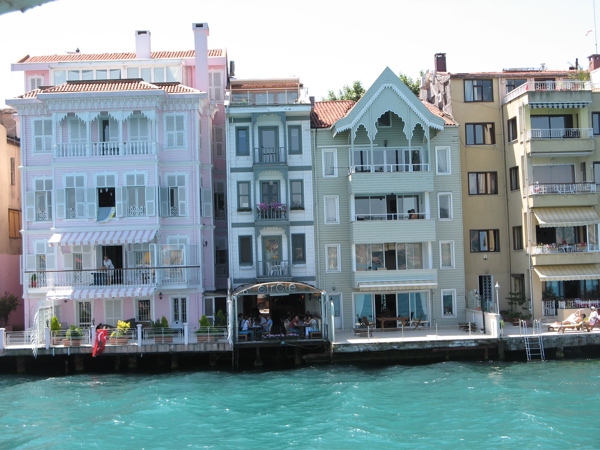
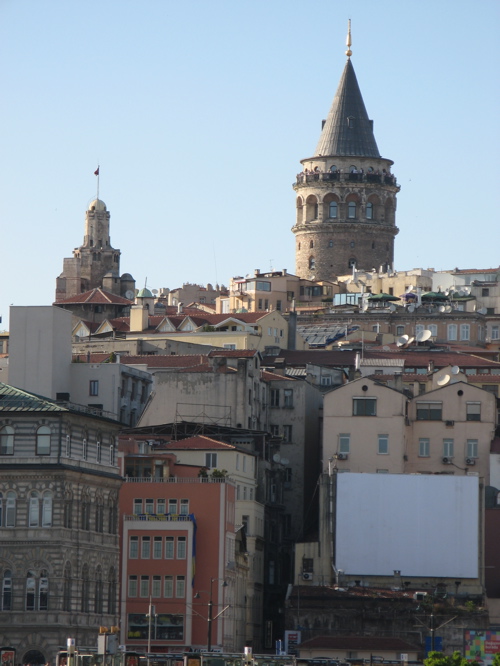
When we returned to the old city, we visited the Spice Bazaar again
(and purchased some things this time) and then went back to Taksim.
We chose our two favorite spots to finish on - the restaurant we
had gone to with Sadik and Bayram that had the phenomenal stuffed
eggplant (amongst many other delicious things) and, of course, Saray for dessert.
We finally ordered the right amount - one serve of our
favorite
Burma Kadayıf. The perfect end to a great day.
Sunday we only had the morning, but we had planned to go into the old
city for one last look around. We stopped at Saray for a last
glass of tea and Turkish coffee (and
didn't succumb
to the temptation of all the goodies there because we were well and
truly tired of eating) before getting our luggage and going to the
airport.
Istanbul - and what little we saw of Turkey as a whole - was much more
interesting and beautiful than we had expected ... and we had pretty
high expectations going. Other than feeling like we need to be on
a diet for the next month, it was a perfect couple of weeks.
